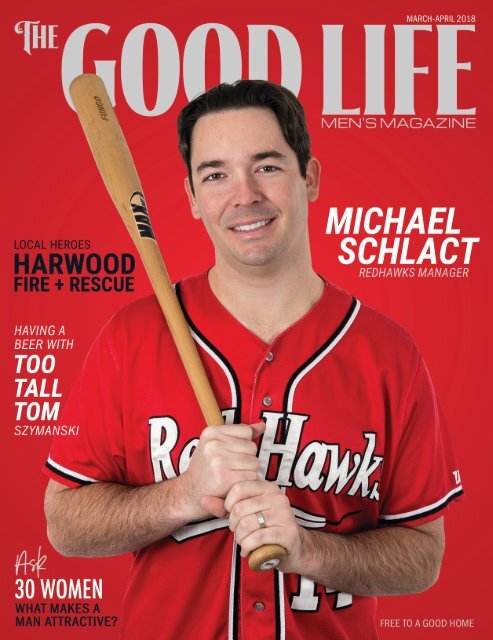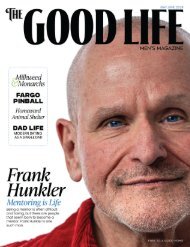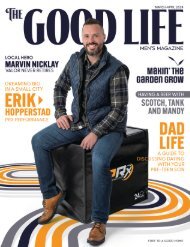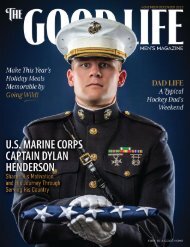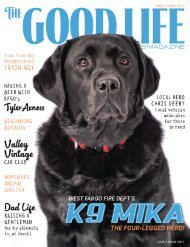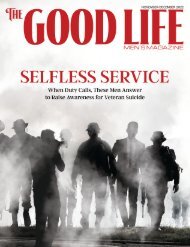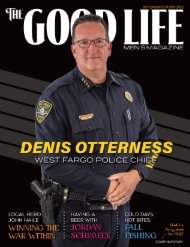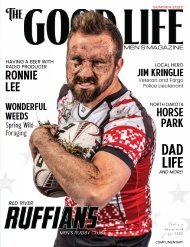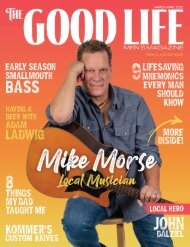The Good Life – March-April 2018
Featuring the new FM Redhawks coach Michael Schlact. Local Heroes - Harwood Fire and Rescue, Having a Beer with Too Tall Tom Szymanski and more in Fargo Moorhead's only men's magazine.
Featuring the new FM Redhawks coach Michael Schlact. Local Heroes - Harwood Fire and Rescue, Having a Beer with Too Tall Tom Szymanski and more in Fargo Moorhead's only men's magazine.
You also want an ePaper? Increase the reach of your titles
YUMPU automatically turns print PDFs into web optimized ePapers that Google loves.
FATHERS // MR. FULL-TIME DAD<br />
I May Have Been Overly Optimistic About Everything<br />
WRITTEN BY: BEN HANSON<br />
A few months back, I wrote in these very pages about how<br />
the transition from a 1-year-old to a 2-year-old didn’t seem<br />
all that scary. I dared the “terrible twos” to bring it on,<br />
putting my hubris on display for all the world to read. Well,<br />
I may have made a huge mistake.<br />
Six months ago when I was feeling so optimistic about<br />
the challenge of parenting a 2-year-old, Macklin was still a<br />
baby for all practical purposes. He was only just becoming<br />
self aware, which means his mom and I were still able to<br />
steer his behavior and mood with great effect. Fast forward<br />
to now, with changes hurtling at us from every direction,<br />
including his increasing cognitive independence, and I<br />
couldn’t tell you with any degree of certainty what kind of<br />
Mack we’ll be dealing with even five seconds from now.<br />
A Two in Three’s Quarters<br />
<strong>The</strong> big shift started the day we were notified by that<br />
Macklin would be transitioning up to the next class at<br />
daycare. His move from the twos room to the threes<br />
came as more of a shock to his mother and me than it<br />
did him… I mean he’s a 2-year-old who’s still getting the<br />
hang of object permanence. Something as abstract as a<br />
forthcoming change of setting — as impactful as it proved<br />
to be — was beyond his cognitive grasp.<br />
We had three weeks to prepare for the move, including<br />
one week of gradual transition where Macklin would<br />
spend part of his day in his regular room and the other<br />
part in his new room. That was when the so-called<br />
“terrible twos” first made an appearance.<br />
Out of nowhere, the tantrums started. And for the littlest<br />
of things. For example, letting the dog out. How dare<br />
I open the sliding glass door to let Lucy out back for a<br />
potty break without first consulting Macklin! We learned<br />
quickly that if he was able to carry out a task, we’d better<br />
ask him first if he’d like to do it. Otherwise, tantrum. “I do<br />
it! I do it!” On the upside, these tantrums only last a few<br />
seconds… but a day full of micro-tantrums can still make<br />
for a long day.<br />
2 / THE GOOD LIFE / urbantoadmedia.com
We’ve also learned that “no” often means “ask me again<br />
in two seconds.” We got to the point of discussing the<br />
pros and cons of who would let the dog out, how there<br />
would be countless more opportunities to slide that<br />
door open and the reality of how the animal digestive<br />
system operates round the clock.<br />
<strong>The</strong> Big Boy Bed<br />
Another monumental change, but this time one he’d<br />
been asking for. Ever since we went to visit the in-laws<br />
and discovered his two little cousins were now sleeping<br />
in “big girl” bunk beds, Macklin began asking when he<br />
was going to get a “big boy” bed of his own. We couldn’t<br />
resist, as the introduction of a twin bed into the mix<br />
held the promise of more snuggles and a better excuse<br />
for falling asleep during nap time.<br />
In hindsight, however, a wiser choice on our part may<br />
have been to wait until after the daycare transition was<br />
complete before introducing another new variable to<br />
his routine. Change is tough for us adults, but it’s even<br />
tougher for a toddler who has only known one thing…<br />
be it a classroom or a bedroom configuration.<br />
His new bed inadvertently moved him one step closer to<br />
independence, and he knew it immediately. Apparently,<br />
with big boy beds come big boy responsibilities, or so<br />
he believed. We’ve smoothed out our evening routines<br />
since, but those first few weeks were a definite<br />
regression in the battle of wills I now realize may have<br />
no end.<br />
Potty Training<br />
I don’t blame daycare for the unavoidable challenge that<br />
is potty training, but with his move up to the threes room<br />
came with the condition that potty training become top<br />
priority. So, to recap, in the span of a couple of weeks,<br />
Mack changed rooms, changed beds and is now, at least<br />
occasionally, walking around with poop in his pants.<br />
For the first time, I’ve stopped being jealous of his life…<br />
if only momentarily.<br />
Similarly — and thankfully — I’ve learned that potty<br />
training is only awful momentarily. Bringing home a<br />
bag full of soiled clothing from daycare is awful, but<br />
only for a moment. You either throw that whole bag in<br />
the garbage before entering the house, or you throw it<br />
into the wash and forget about it (pretreated, of course).<br />
Overall, the twos aren’t bad for Macklin. <strong>The</strong>y’re just<br />
another developmental stage he must go through, and<br />
we’re along for the ride. His growing independence is<br />
what makes it hard for us. Everyday he’s coming up with<br />
more of his own opinions and ideas, most of which are<br />
fun and creative. Others are just, well… inconvenient.<br />
Potty training — and his feelings about it — fall into the<br />
latter category. <strong>The</strong> good news is it’s all momentary. •<br />
urbantoadmedia.com / THE GOOD LIFE / 3
Contents<br />
MARCH-APRIL <strong>2018</strong> / VOLUME 5 • ISSUE 5<br />
FATHERS / MR. FULL-TIME DAD<br />
TWOS POTENTIALLY TERRIBLE<br />
AFTER ALL<br />
02<br />
F-M FENCING CLUB<br />
LET'S GET RIGHT TO THE POINT<br />
GRILLING & TRADITIONS<br />
AROUND THE WORLD<br />
06<br />
10<br />
HAVING A BEER WITH<br />
TOM SZYMANSKI<br />
12<br />
ASK 30 WOMEN<br />
WHAT MAKES A MAN<br />
ATTRACTIVE?<br />
16<br />
ON THE COVER<br />
MICHAEL SCHLACT<br />
REDHAWKS MANAGER<br />
MAKES FARGO-MOORHEAD<br />
"HOME AWAY FROM HOME"<br />
18<br />
UNITED WAY'S<br />
BOLD GOAL TO REDUCE<br />
HOMELESSNESS<br />
IN OUR COMMUNITY<br />
THROUGH HOUSING FIRST<br />
24<br />
LOCAL HEROES<br />
HARWOOD FIRE & RESCUE<br />
30<br />
4 / THE GOOD LIFE / urbantoadmedia.com
PUBLISHED BY<br />
Urban Toad Media LLP<br />
www.urbantoadmedia.com<br />
OWNER / GRAPHIC DESIGNER<br />
Dawn Siewert<br />
dawn@urbantoadmedia.com<br />
OWNER / PHOTOGRAPHER<br />
Darren Losee<br />
darren@urbantoadmedia.com<br />
CONTRIBUTING WRITERS<br />
Meghan Feir<br />
Ben Hanson<br />
Kristi Huber<br />
Krissy Ness<br />
Danielle Teigen<br />
ADVERTISING INQUIRIES<br />
Darren Losee / 701-261-9139<br />
darren@urbantoadmedia.com<br />
READ A PAST ISSUE<br />
issuu.com/thegoodlifemensmag<br />
LIKE<br />
facebook.com/<br />
urbantoadmedia<br />
TWEET<br />
@urbantoadmedia<br />
<strong>The</strong> <strong>Good</strong> <strong>Life</strong> Men’s Magazine is distributed six times<br />
a year by Urban Toad Media LLP. Material may not be<br />
reproduced without permission. <strong>The</strong> <strong>Good</strong> <strong>Life</strong> Men’s<br />
Magazine accepts no liability for reader dissatisfaction<br />
arising from content in this publication. <strong>The</strong> opinions<br />
expressed, or advice given, are the views of individual<br />
writers or advertisers and do not necessarily represent<br />
the views or policies of <strong>The</strong> <strong>Good</strong> <strong>Life</strong> Men’s Magazine.<br />
urbantoadmedia.com / THE GOOD LIFE / 5
WRITTEN BY: KRISSY NESS<br />
PHOTOGRAPHY: URBAN TOAD MEDIA<br />
If you have ever been interested in<br />
fencing but don’t know where to<br />
begin, F-M Fencing Club is a great<br />
place to start. Beginners are welcome<br />
to join in anytime and the club will<br />
supply them with equipment until<br />
they are able to purchase their own.<br />
<strong>The</strong> F-M Fencing Club has been<br />
running from its current location,<br />
Grace Lutheran School, in Fargo,<br />
ND, since 2011 and the arrangement<br />
is a perfect fit. With the exception<br />
of their weapons, the school has<br />
graciously offered them storage for<br />
all of their equipment and a full size<br />
gym to practice in. “<strong>The</strong>y allow us to<br />
use a closet in the gym to store all of<br />
our equipment,” said Bianco.<br />
Dr. Robert Bianco PhD has been<br />
fencing foil since 1996. — Foil<br />
is one of three weapons in this<br />
Olympic sport, all of which are<br />
metal. A Foil is flexible, rectangular<br />
in cross section, and weighs under a<br />
pound. A foil fencer's uniform features<br />
the lamé, which is a vest, electrically<br />
wired to record hits. It is the most<br />
commonly used weapon when beginning<br />
to learn the sport.<br />
Dr. Bianco began in grad school at the<br />
University of North Dakota and continued to<br />
fence while attending <strong>The</strong> University of Iowa<br />
as he worked on his postdoctoral fellowship.<br />
It was there that he participated in foil and the<br />
occasional saber event in the UI club. He moved<br />
back to the F-M area in 2006 and still had the itch<br />
6 / THE GOOD LIFE / urbantoadmedia.com
“We put together a<br />
non-profit so we could get<br />
more kids fencing and now we<br />
have 9 year-olds all the way<br />
up to veteran class fencers.”<br />
— Dr. Bianco<br />
urbantoadmedia.com / THE GOOD LIFE / 7
to keep fencing but found the closest<br />
place to do so was in Grand Forks,<br />
ND.<br />
In 2007, Dr. Bianco started a fencing<br />
club at Minnesota State University<br />
Moorhead providing courses in the<br />
multi-weapon group, however they<br />
were on their way out. “I sought out a<br />
couple of students who were willing<br />
to continue and do the student<br />
organization paperwork and that<br />
club just exploded; they just needed<br />
coaching,” said Dr. Bianco.<br />
After a while, Dr. Bianco went to the<br />
Coaches’ College, which was put<br />
on by the Olympic authority. At that<br />
time they were trying to consolidate<br />
what was being taught in the fencing<br />
community within the country. “I<br />
coached there for many years, and<br />
Enrique [Alvarez] walked in one<br />
day…and he was like we should do<br />
a community group; and so we did,”<br />
said Dr. Bianco. “We put together a<br />
non-profit so we could get more kids<br />
fencing. Now we have 9 year-olds all<br />
the way up to veteran class fencers.”<br />
Children ages 9-12 participate in the<br />
Musketeers program, Intro classes<br />
and school programs range from 12-<br />
18 and adult classes are 18+.<br />
8 / THE GOOD LIFE / urbantoadmedia.com<br />
Enrique Alvarez hails from Oviedo,<br />
Spain but has lived in the F-M area for<br />
over 10 years. He began fencing when<br />
he was 14 and was certified a fencing<br />
coach level 1 by the AEMA (Spanish<br />
association of fencing masters) by<br />
1999, and in 2011 he received his<br />
title of Fencing Master, which is the<br />
highest level of accreditation by the<br />
United States Fencing Coaching<br />
Association and by the International<br />
Academy of Arms.<br />
Both Alvarez and Dr. Bianco are<br />
head coaches for F-M Fencing.<br />
Alvarez focuses on Epee — designed<br />
for thrusting and used, with the end<br />
blunted, in fencing, while Bianco<br />
focuses on Foil.<br />
<strong>The</strong> opportunity to learn fencing from<br />
these two coaches is quite a treat, not<br />
to mention they have three assistant<br />
coaches who are just as passionate<br />
about fencing as Alvarez and Bianco.<br />
This club has been featured for the<br />
last couple of years in various forms<br />
of media in the Red River Valley and<br />
it just goes to show that if there is a<br />
club for it people will show up. All<br />
of the coaches volunteer their time<br />
because they truly love the sport.<br />
Last year four members from the<br />
F-M Fencing club headed to Salt<br />
Lake City, Utah to participate in the<br />
National Fencing Championship.<br />
Fencers come from all across the<br />
country and must qualify to share<br />
in this competition and it shows just<br />
how much work these athletes put<br />
into their craft to make it that far.<br />
This group has been a great addition<br />
to the Fargo-Moorhead area for many
“I always say for fencing, it’s pure joy.” — Dr. Bianco<br />
reasons; one major one being it is a great<br />
way to get exercise. Fencing takes a great<br />
deal of skill and athletic ability so you must<br />
stay agile to be a threat in competition. When<br />
speaking about him and his fellow coaches<br />
Bianco joked, “We’re old and it hurts when we’re<br />
done, but it’s always worth it.”<br />
<strong>The</strong> good life means something different to many<br />
people but for Bianco it’s pretty simple. “I always say<br />
for fencing, it’s pure joy.” •<br />
urbantoadmedia.com / THE GOOD LIFE / 9
UNITED STATES // Barbecue Grill<br />
Americans pretty much grill whatever they<br />
can get their hands on <strong>–</strong> meats, vegetables<br />
and even pizza. But the most common<br />
grilled foods are: Hamburgers, hot dogs,<br />
chicken breast, pork ribs and brats.<br />
JAMAICA // Barbecue Grill<br />
Like America, Jamaicans call it Barbecue<br />
and often use barrel grills. <strong>The</strong>ir most<br />
popular dish is jerk chicken which is meat<br />
dry-rubbed or wet marinated with a hot<br />
spice mixture called Jamaican jerk spice.<br />
GERMANY // Schwenkgrill<br />
In Germany food is cooked on a swinging<br />
grill over hot coals. German barbecue is<br />
called Schwenker. <strong>The</strong>ir most popular dish<br />
is Schwenkbraten <strong>–</strong> pork neck steak. A<br />
person who operates the Schwenker grill is<br />
called Schwenker or a Schwenkermeister.<br />
10 / THE GOOD LIFE / urbantoadmedia.com
KOREA // Gogigui<br />
Korean barbecue, or Gogigui, is often<br />
cooked on a table grill. <strong>The</strong>ir most popular<br />
dish is Bulgogi <strong>–</strong> usually made from thinly<br />
sliced marinated beef, pork or chicken. It<br />
often comes with various banchan (side<br />
dishes) served along with cooked rice.<br />
JAPAN // Hibachi<br />
Japanese barbecue, grilled on a flattop<br />
is called Hibachi. <strong>The</strong> literal meaning of<br />
hibachi is "fire bowl". Hibachi is the cooking<br />
of meat, vegetables and seafood on a high<br />
heat. Hibachi grills can be portable or built<br />
into furniture. <strong>The</strong>ir most popular dish is<br />
Yakitori (skewered chicken).<br />
SOUTHERN, CENTRAL AND<br />
WEST ASIA // Tandoor<br />
Tandoor clay pot ovens are typically used<br />
throughout the Middle East, India, Pakistan<br />
and even parts of Central Asia. A fire is built<br />
on the bottom which heats both the walls<br />
of the oven and the air inside. Tandoori is<br />
the most popular dish made of marinated<br />
meats, yogurt, herbs and spices such<br />
as ginger, garlic, coriander powder and<br />
cayenne pepper.<br />
NORTH AFRICA // Tagines<br />
Tagines are primarily used to slow-cook<br />
savory stews and vegetable dishes. <strong>The</strong><br />
cone-shaped lid of the tagine traps steam<br />
and returns the condensed liquid to the<br />
pot. <strong>The</strong> traditional method of cooking with<br />
a tagine is to place the tagine over coals.<br />
urbantoadmedia.com / THE GOOD LIFE / 11
HAVING A BEER WITH // TOM SZYMANSKI<br />
HAVING A BEER WITH<br />
TOO TALL<br />
TOM SZYMANSKI<br />
WRITTEN BY: MEGHAN FEIR • PHOTOGRAPHY: URBAN TOAD MEDIA<br />
On a regular hair-ruining, facefreezing<br />
day in Fargo, I made my<br />
way to Drekker Brewing Company<br />
to meet up with one of the area’s<br />
most easily recognizable figures in<br />
broadcasting: Tom Szymanski, aka<br />
Too Tall Tom.<br />
For over 35 years, Szymanski, the<br />
chief meteorologist for KFGO, has<br />
been a regular part of thousands<br />
of people’s days, bringing weather<br />
to them with enthusiasm and<br />
good humor. From Wisconsin to<br />
Maine, television to radio, he has<br />
harnessed his lifelong interest in<br />
scientifically predicting weather<br />
patterns to help the public stay<br />
safe and informed in various places<br />
across the nation.<br />
<strong>Good</strong> <strong>Life</strong>: Was there a time in your<br />
life when you were just like, “I’m<br />
going all out. I’m going to look like<br />
the quintessential person of this<br />
generation”?<br />
Tom Szymanski: At the time we<br />
went through the fashions of the<br />
‘70s, I hated them, but everybody<br />
else wore them, so I felt like I had<br />
to. I did not like polyester. I did<br />
not like bell-bottoms. My mother<br />
always got me these shirts with<br />
bell sleeves where the sleeves are<br />
all puffed up by the forearms, and<br />
they looked so stupid. I did not get<br />
suckered into the platform shoes<br />
because I didn’t need them. I was 6<br />
feet tall by the time I was 10.<br />
GL: I was one of the tallest people<br />
in middle school, but then I<br />
stopped growing by eighth grade<br />
and everybody else passed me in<br />
height, so I was like, “Okay, bye.”<br />
TS: See, I was the opposite. I was<br />
one of the shortest in my class,<br />
and then, all of a sudden, by fourth<br />
grade I was like, “Buh-bye! I’m way<br />
taller than you guys now.”<br />
GL: What is it like being able to<br />
reach high cupboards and shelves?<br />
I climb things.<br />
TS: Hey, you did for some pictures<br />
today, too. It’s good! If nothing works<br />
out in my retirement years, I can<br />
always be a stock boy. I always like<br />
to think it gave me an advantage.<br />
Being tall you can see over crowds.<br />
<strong>The</strong>re are some drawbacks, like<br />
finding clothes and sitting in<br />
airplanes. I wear size 16 shoes, so<br />
“My mother taught me as a kid to never interrupt people.<br />
It seems like a lost art. Everybody’s talking and<br />
nobody seems to be listening.” — Tom Szymanski<br />
12 / THE GOOD LIFE / urbantoadmedia.com
5'4"<br />
6'9"<br />
you can’t find those everywhere.<br />
But overall, I wouldn’t trade it for<br />
anything.<br />
GL: What’s one of your biggest<br />
pet peeves?<br />
TS: Stupid drivers in the winter<br />
— people who drive too fast for<br />
conditions. <strong>The</strong>y see the speed<br />
limit sign and think that that’s<br />
how fast they have to go. Another<br />
one is how people don’t let other<br />
people finish their sentences;<br />
they start talking over them<br />
all the time. My mother taught<br />
me as a kid to never interrupt<br />
people. It seems like a lost art.<br />
Everybody’s talking and nobody<br />
seems to be listening. When that<br />
happens in a group of people, I<br />
just clam up, sit there and don’t<br />
say anything.<br />
urbantoadmedia.com / THE GOOD LIFE / 13
HAVING A BEER WITH // TOM SZYMANSKI<br />
GL: You know you’re going to get<br />
interrupted anyway.<br />
TS: Right. Another one would be<br />
when you go out and see people<br />
just on their phones and they’re not<br />
even interacting with each other.<br />
I could actually turn my phone off<br />
for an entire weekend and not even<br />
look at it. It’s like some people’s<br />
lifeline. Somehow, we survived<br />
before cell phones were invented.<br />
GL: If you chose to live an<br />
alternative lifestyle, like living in an<br />
igloo with penguins, what would<br />
you want to do?<br />
TS: I would do what I want to do<br />
when I retire. I’d like to spend<br />
some of the winter in Arizona to<br />
get away from the cold. I’d sit on<br />
a lawnmower and cut grass for<br />
a golf course and get free golf in<br />
exchange for it. My wife is a very<br />
serious golfer, too. I met her 15<br />
years ago on a golf course, and ever<br />
since then, it’s our passion.<br />
GL: How has your personality<br />
changed over the years?<br />
TS: Anybody who knows me well<br />
knows that I’m actually pretty<br />
shy and reserved. But I had a<br />
broadcasting alter ego. I was<br />
aggressive, verbose and loud.<br />
<strong>The</strong>re’s Too Tall Tom, which is<br />
my TV/radio persona, and then<br />
there’s Tom Szymanski, and<br />
they’re divergent characters —<br />
same person, but different. If I’m<br />
representing the television or radio<br />
station, I’ll put on my Too-Tall-Tom<br />
hat and I’ll be what people expect<br />
me to be. As soon as that’s over,<br />
it’s like turning a switch; it’s back<br />
to being me. Over the years, I’ve<br />
gotten quieter and just mellowed<br />
out, I suppose. It happens to all of<br />
us, as we get older.<br />
GL: What’s one piece of advice you<br />
have?<br />
TS: I always tell kids that it’s real<br />
simple, no matter what you choose<br />
to do. When the alarm goes off in<br />
the morning, if you don’t want to<br />
get up, you should consider doing<br />
something else for a living. My dad<br />
14 / THE GOOD LIFE / urbantoadmedia.com
“When the alarm<br />
goes off in the<br />
morning, if you<br />
don’t want to get up,<br />
you should consider<br />
doing something else<br />
for a living.”<br />
— Tom Szymanski<br />
taught me that. You should<br />
want to get up, rather than<br />
have to get up. I always like<br />
getting up because I’m doing<br />
exactly what I want to be<br />
doing.<br />
GL: What does the good life<br />
mean to you?<br />
TS: Living the good life is<br />
finding the balance among<br />
family, friends and career<br />
and leaving plenty of time for<br />
yourself. If you can find the<br />
balance in all of that, you’re<br />
successful. If I can get out and<br />
do what I love to do, as long as<br />
I’m physically able, I think I’m<br />
living the good life. •<br />
urbantoadmedia.com / THE GOOD LIFE / 15
Ask 30 WOMEN<br />
WHAT MAKES A MAN ATTRACTIVE?<br />
tattoos<br />
sense of humor<br />
confidence<br />
great hair<br />
no man buns<br />
be handy<br />
communication<br />
a strong will<br />
It seems like a simple question, right? Tall, dark, handsome...<br />
Well gentleman, after asking 30 random women "What make a man attractive?" a personality and a sense<br />
of humor will take you from an 8 to a 10. Although physical appearance is important, how you treat a lady is<br />
more attractive than how you look.<br />
1. Confidence.<br />
2. Personality, sense of humor,<br />
confidence but not arrogance, nicely<br />
dressed, nice smile. A chiseled jaw<br />
and six pack abs.<br />
3. Funny, tattoos, facial hair.<br />
4. Makes me laugh, kind heart, good<br />
personality.<br />
5. Family means everything to me.<br />
If you can’t make them smile, you<br />
can’t be with me!<br />
6. Compassion, intelligence,<br />
humility, and great hair.<br />
16 / THE GOOD LIFE / urbantoadmedia.com<br />
7. Someone kind and considerate.<br />
8. Eyes, styled hair, a gentleman,<br />
confidence, makes me laugh,<br />
morales and faith in God, tattoos<br />
and rides a motorcycle.<br />
9. Confidence but not cockiness.<br />
10. Kindness and confidence. A<br />
willingness to do whatever needs to<br />
be done. It's very sexy when a man<br />
will stop what he is doing to help<br />
without being asked.<br />
11. Smart and funny.<br />
12. Generosity.<br />
13. Communication skills. It’s a<br />
huge turn off when a guy uses poor<br />
English, vulgar slang and does<br />
things like snap or whistle at a<br />
waitress to order a drink.<br />
14. His teeth.<br />
15. A guy driving a well taken care<br />
of old pickup truck with his dog by<br />
his side.<br />
16. Confidence and the way they<br />
treat others are what makes a man<br />
attractive in my eyes, but a few<br />
tattoos don’t hurt either.
LADIES <strong>–</strong> If you would like to<br />
participate in our next Ask 30 Women,<br />
follow us on our Facebook page at:<br />
www.facebook.com/urbantoadmedia<br />
17. Metrosexual. Take a little time<br />
on yourself. No beard! No baseball<br />
caps! No buzz cuts! Be handy,<br />
thread your own hose on to a<br />
spicket at least.<br />
18. A pulse.<br />
19. I think the thing that makes<br />
a man most attractive is his<br />
personality along with a great sense<br />
of humor, because I love to laugh.<br />
20. Personable, and they have a<br />
good job.<br />
21. Tall, light, and handsome. Must<br />
be honorable and have integrity.<br />
22. Dark hair, light eyes. Fit. Tattoos<br />
are a plus. Clean haircut, doesn’t<br />
have to be crazy short but just clean<br />
looking, not a long nasty mess. No<br />
man buns. No crazy facial hair,<br />
preferably clean shaven or 5 o’clock<br />
shadow. <strong>The</strong> taller the better.<br />
23. Honestly, hockey and Star Wars<br />
moves them way up to the top.<br />
24. Respectful, noticing and doing<br />
“the little things”.<br />
25. Style, demeanor and<br />
personality.<br />
26. A gentle heart and strong will.<br />
27. His eyes, sense of humor.<br />
His ability to listen, if he's a good<br />
hugger - that's a necessity. And<br />
his hands. I like rough hands. I<br />
don't want a man whose hands are<br />
softer than mine.<br />
28. <strong>Good</strong> with kids and has pets.<br />
Likes dogs and cats <strong>–</strong> not creepy<br />
pets. Nice arms.<br />
29. A good haircut, well-groomed, it<br />
shows he takes care of himself and<br />
it’s just classy. Kindness.<br />
30. Looks you in the eyes and is<br />
interested in what you are saying.<br />
graphic design services<br />
brand identity design<br />
logo design<br />
professional photograpy<br />
advertising / marketing<br />
materials<br />
urbantoadmedia.com<br />
urbantoadmedia.com / THE GOOD LIFE / 17
COVER // MICHAEL SCHLACT<br />
18 / THE GOOD LIFE / urbantoadmedia.com
MICHAEL SCHLACT<br />
RedHawks Manager Makes Fargo-Moorhead “Home Away From Home”<br />
WRITTEN BY: DANIELLE TEIGEN • PHOTOGRAPHY: URBAN TOAD MEDIA<br />
It’s an adage that’s older than the sport of baseball<br />
itself: home is where the heart is. And in a sport where<br />
a player or coach can be transferred at a moment’s<br />
notice, an incredible level of flexibility and adaptability<br />
is required.<br />
For Michael Schlact, who became manager of the<br />
FM RedHawks in September 2017, the phrase has<br />
become a family mantra for him, his wife, Jillian, their<br />
nearly 3-year-old son Sawyer and the newest family<br />
member <strong>–</strong> another little boy <strong>–</strong> due to arrive this month.<br />
For these high school sweethearts, being together<br />
<strong>–</strong> no matter where “together” takes them <strong>–</strong> is more<br />
important than anything else.<br />
Where it all began<br />
Schlact and his wife grew up in Marietta, Georgia<br />
(where they still maintain home base today), and he<br />
was active in a variety of activities, not just sports <strong>–</strong><br />
piano, theater, etc.<br />
“My parents wanted me to try everything so once<br />
I picked something, they’d know I wasn’t forced<br />
into anything,” he explained one January afternoon<br />
at a downtown coffee shop. He was in town to do<br />
promotional activities, and the temperature that day<br />
was a balmy 25 degrees, but for someone born and<br />
raised in the south, the cold was a little brisk.<br />
But Schlact brushed it off, explaining that the warmth<br />
of the Fargo-Moorhead community permeates much<br />
deeper than any chilly winter breeze. But more on that<br />
later.<br />
Thanks to experimenting with so many different<br />
activities, Schlact knew by the time he graduated<br />
from Joseph Wheeler High School that he wanted<br />
to play baseball professionally, although coaching<br />
was not a profession he was ever considering. He<br />
was drafted in the third round in 2004 by the Texas<br />
Rangers, where he stayed for seven seasons. That’s<br />
also where he was when he had his first shoulder<br />
surgery and his first moment’s pause that playing<br />
might not last.<br />
“I had no idea I wanted to be a coach - I wanted to be<br />
a major leaguer as a player,” he said. “Our identities<br />
get so wrapped up in what we do, which isn’t good<br />
because it’s not permanent.”<br />
But that day in 2009, the 6’7” pitcher threw the ball<br />
and immediately felt a pain like a knife stabbing him<br />
in the shoulder.<br />
He spent a year rehabilitating, discovering as he<br />
sat on the bench and talked with his teammates<br />
that other guys were scared of getting injured as<br />
well, but he could ease that worry by sharing his<br />
experience.<br />
Schlact was back on the field for the 2010 season,<br />
but in 2013, he injured his shoulder again but<br />
this time, he was thinking about retirement. After<br />
talking about it with his wife, Schlact approached<br />
his coach, Bobby Brown (who is now with the<br />
Lincoln Salt Dogs), who told him to spend some<br />
time with him.<br />
urbantoadmedia.com / THE GOOD LIFE / 19
COVER // MICHAEL SCHLACT<br />
“He saw a coach in me,” Schlact said.<br />
So how did a guy from Georgia who played<br />
professionally in Texas and Kansas end up in Fargo,<br />
North Dakota?<br />
Two words: Doug Siminic.<br />
<strong>The</strong> longtime RedHawks manager knew many<br />
other managers and position coaches, so when the<br />
RedHawks needed a pitching coach, Schlact received<br />
the call.<br />
“I’ll never forget that moment <strong>–</strong> I was at a park with<br />
my wife and Doug called to ask if I wanted to be a<br />
pitching coach,” Schlact recalled.<br />
He accepted, but it was an interesting situation; his<br />
wife was pregnant with their son and due May 2. But<br />
he had to be in Fargo by May 1.<br />
<strong>The</strong> Schlacts decided to head north early, selecting a<br />
hospital and doctor online, and discovering throughout<br />
the process of having the baby that they’d made some<br />
great choices.<br />
“Our first taste of how awesome this place is was<br />
through the birthing process,” he said. <strong>The</strong> day after<br />
his son was born, Schlact stepped foot in Newman<br />
Outdoor Field as the pitching coach, and by the next<br />
week, he hit the road with the team for exhibition<br />
games.<br />
Learning to be a coach<br />
<strong>The</strong> transition from player to coach involved learning<br />
<strong>–</strong> a lot of learning.<br />
“When you sit in a dugout next to Doug Siminic and<br />
you look at everything he did and the championships<br />
the RedHawks won, you can only learn it by<br />
experiencing it through someone who lived it,”<br />
Schlact said.<br />
While the first year as the RedHawks pitching coach<br />
was a learning experience, Schlact said he was able<br />
to hit the ground running the next year. By 2017, he<br />
was feeling confident and at ease.<br />
And then “that day” happened.<br />
That day, of course, is Aug. 13, when Siminic was<br />
fired, around 10 a.m. that Sunday morning, Schlact<br />
was called up to be interim manager and just hours<br />
later, the RedHawks took the field.<br />
“It was a lot to take in,” Schlact said. “I’m thankful<br />
for what Doug had done for the team and thankful<br />
for what Doug had given me, but from a human<br />
element, I was sad for him as a person. <strong>The</strong><br />
RedHawks were his life.”<br />
Along with the admiration and respect Schlact felt<br />
for Doug as a coach and a person, he also said he<br />
realizes that the RedHawks franchise is a business,<br />
and the players and coaches all have a job to do.<br />
20 / THE GOOD LIFE / urbantoadmedia.com
After “that day,” Schlact took the next<br />
24 hours to process his emotions<br />
and by the next morning, he was<br />
ready to move forward with the<br />
team. “It was tough, but I got all of<br />
my emotions out of the way,” he said.<br />
Naturally, Schlact felt a little unsure<br />
about embracing his new role.<br />
“Admittedly, I was a little nervous,<br />
especially in those circumstances,”<br />
he said.<br />
To this day, Schlact feels gratitude<br />
toward Siminic.<br />
“I’m just thankful he put me in a position<br />
to get into professional baseball and for<br />
giving me the opportunity to coach,” he<br />
said.<br />
As the rest of the 2017 season went on,<br />
Schlact gained confidence and watched<br />
as the RedHawks ended in a three-way<br />
wild card playoff spot tie.<br />
As the season ended, the word<br />
“interim” was removed from<br />
Schlact’s title.<br />
In a Sept. 8, 2017, Forum<br />
article, RedHawks president<br />
and chief executive officer<br />
Brad Thom said the decision<br />
to name Schlact as manager<br />
was made easier after a<br />
veteran player came to him<br />
and requested it. “I talked to<br />
a bunch of players after the<br />
season was over, and there<br />
was not one bad word to say<br />
about Michael.”<br />
Stepping into a new role<br />
Throughout this entire<br />
process of becoming the<br />
official manager, Schlact has<br />
remained humble about the<br />
opportunity he’s been given.<br />
“It’s a big blessing,” he said.<br />
So what can fans expect<br />
from Schlact as a manager?<br />
urbantoadmedia.com / THE GOOD LIFE / 21
COVER // MICHAEL SCHLACT<br />
“<strong>The</strong> tradition and pride that comes with wearing the<br />
RedHawks logo, definitely,” Schlact responded with no<br />
hesitation. “Our first priority is playing good baseball.<br />
But the second is to give back to this community, to<br />
be a positive part of this community. We want to give<br />
back to the people who’ve given so much to us.”<br />
Having been a player so recently, Schlact said he wants<br />
the RedHawks players who aren’t from the Fargo-<br />
Moorhead area originally to immerse themselves in<br />
the community.<br />
“I want them to experience what I’ve experienced<br />
in my time here,” he said. “I want to invite families<br />
in more often, and I want them to know more about<br />
us as people... I want people to know us for being<br />
approachable and family friendly.”<br />
Choosing to be together<br />
Family friendly is not a term Schlact takes lightly.<br />
Being a professional baseball player is hard enough for<br />
one person when it comes to abrupt moves, so having<br />
two people to consider is infinitely more difficult.<br />
His wife has a degree in childhood education, but once<br />
they were married, she put her career on the shelf.<br />
“She said, ‘We just need to be together,’” he recalled.<br />
“One season we moved five times.” During those crazy<br />
transitions, Schlact flew to his new team’s hometown<br />
while his wife stayed behind to pack the apartment<br />
and then drive to meet him in their new city.<br />
“It was just something we did,” he said.<br />
Now, with a second child on the way, the process of<br />
staying together will be a hair crazier, but more fun.<br />
“We have an SUV, so if it fits, we bring it,” he said.<br />
By the end of <strong>April</strong>, the family (which also includes a<br />
Pomeranian) will be settling into their apartment in<br />
south Fargo, and the fun really begins.<br />
“My son loves the Friday fireworks and on Sundays,<br />
he gets to run the bases with Dad,” he said. While the<br />
22 / THE GOOD LIFE / urbantoadmedia.com
fun is important, Schlact knows his children will have<br />
a well-rounded perspective on the world from having<br />
lived in different parts of the country.<br />
And living in Fargo has been a delight.<br />
“Home base is Georgia right now, but home base<br />
is wherever we are together,” he said. While he and<br />
his wife have never officially talked about moving to<br />
Fargo, the notion isn’t ever that far from their minds.<br />
“When my family comes to the ballpark, my son has<br />
ushers who help him and they all feel at home,” he<br />
explained. “We may leave ‘home’ but we come ‘home’<br />
to Fargo.”<br />
Right now, Schlact is focused on his future with the<br />
RedHawks and continuing to build on the legacy<br />
of a foundation already being established. But he’s<br />
experienced enough and seen enough as a player<br />
to know the future may look different than what he<br />
imagines today. But if he’s never not in Fargo, you<br />
better believe the team, the community and the people<br />
have already left an indelible mark.<br />
“Fargo and the RedHawks have set the bar high <strong>–</strong> as<br />
high as the ceiling,” he said. “Other teams don’t have<br />
the fans with the passion, who are coming out by the<br />
thousands every night, that the RedHawks have. And<br />
the coverage of the media here. You don’t have that<br />
everywhere.”<br />
He said in his three years in Fargo, he’s already<br />
created a lifetime of memories with his family. That’s<br />
why it’s so hard for Schlact to choose a favorite aspect<br />
of Fargo <strong>–</strong> there’s too many to name. He joked that<br />
the January opening of Chic-fil-A is definitely worth<br />
noting, but in all seriousness, he couldn’t select one<br />
solitary place or moment or event.<br />
“To be in a place where you feel so safe and feel<br />
accepted, not like an outsider...it’s warmth,” he said.<br />
“You feel it the minute you hit the ground in Fargo.”<br />
So what does the good life look like to Schlact?<br />
“It’s a blend of a job I love, which I’m doing, with an<br />
amazing group of people around me who support me<br />
and my family,” he said. “That’s the good life to me.” •<br />
urbantoadmedia.com / THE GOOD LIFE / 23
UNITED WAY'S<br />
TO REDUCE HOMELESSNESS<br />
IN OUR COMMUNITY<br />
THROUGH HOUSING FIRST<br />
WRITTEN BY: KRISTI HUBER<br />
PHOTOS SUBMITTED BY: UNITED WAY<br />
Right here in our community, according to a recent<br />
point-in time-study, there are approximately<br />
591 local people who are homeless. With<br />
approximately 419 beds available in emergency<br />
shelters and transitional housing programs,<br />
this leaves nearly 200 men, women and<br />
children who may find themselves homeless<br />
on any given night in the community we call<br />
home.<br />
Solving Homelessness for <strong>Good</strong><br />
United Way of Cass-Clay changing the way<br />
we address issues like homelessness,<br />
hunger, poverty, and mental health.<br />
We’re bringing the right partners<br />
together to tackle the source and<br />
root cause <strong>–</strong> not just the symptoms.<br />
We invite the community to “Be a<br />
Force for <strong>Good</strong>.” “For good” means<br />
that we not only want to make a<br />
positive impact, but we want to<br />
solve issues like homelessness<br />
not just for one night, or<br />
temporarily <strong>–</strong> but permanently,<br />
through housing navigators<br />
who put “Housing First.”<br />
24 / THE GOOD LIFE / urbantoadmedia.com
“Once you lose everything,<br />
you lose hope.<br />
But I wanted my son<br />
back <strong>–</strong> that was the most<br />
important thing.”<br />
— Dewayne<br />
urbantoadmedia.com / THE GOOD LIFE / 25
One of United Way’s Bold Community Goals is to Reduce<br />
Hunger and Homelessness. Thanks to support from our<br />
community, a team of innovative housing navigators are<br />
changing the way people, organizations, and systems<br />
work together when it comes to helping people who are<br />
homeless.<br />
Housing Navigators at Work<br />
Thanks to a housing navigator made possible by United<br />
Way, a local man named Dewayne had his life changed<br />
for good.<br />
If you were to meet Dewayne, it is hard to imagine that<br />
just one year ago, Dewayne was homeless and arrested<br />
for panhandling on a Fargo street corner with nowhere<br />
to go, no home, no job, and just the clothes on his back.<br />
Earlier that year, Dewayne and his life partner, Lisa, gave<br />
birth to a baby boy, but soon lost custody of him. Days<br />
after their arrest, Lisa suffered a medical emergency that<br />
left her on life support before passing away in her jail cell.<br />
Not only had Dewayne lost the opportunity to be a father<br />
to his son, but he had lost his life partner as well.<br />
“Once you lose everything, you lose hope. But I wanted<br />
my son back <strong>–</strong> that was the most important thing,” said<br />
Dewayne.<br />
When Dewayne got out of jail, like many individuals<br />
in our community, he fell back into the same cycle of<br />
homelessness and addiction <strong>–</strong> staying in shelters and<br />
passing out on the sidewalks of Fargo, until one day a<br />
housing navigator was standing over him.<br />
Many times, housing navigators literally pick up<br />
individuals off of the street. That is what people need<br />
<strong>–</strong> a connection to the community. <strong>The</strong>y need to know<br />
someone will be there for them and walk the path with<br />
them toward getting an apartment and stable home.<br />
That is exactly what United Way and the housing<br />
navigators are providing.<br />
Thanks to United Way, housing navigators are working<br />
every day in our community to provide support to the<br />
chronically homeless with a goal of helping them to<br />
remove the barriers to attaining and retaining stable<br />
housing.<br />
<strong>The</strong> ripple effect of housing<br />
<strong>The</strong> impact of a housing navigator goes beyond the<br />
people they help. Today, Dewayne is a successful<br />
member of our community, a part of our workforce,<br />
and is destined to achieve his goal of being a good<br />
example for his son. He is a “Force for <strong>Good</strong>” that<br />
impacts us all.<br />
26 / THE GOOD LIFE / urbantoadmedia.com
When people like Dewayne have a stable home, they<br />
can move out of crisis mode and move their life forward.<br />
While we want to see people like Dewayne break free<br />
from that cycle of homelessness, it affects all of us as tax<br />
payers and the economic well-being of our community.<br />
Jesseca White, a Downtown Resource Officer with the<br />
Fargo Police Department, sees United Way’s impact<br />
first-hand and describes it through “Tim.”<br />
“When Tim was homeless, police had to deal with him<br />
hundreds of times throughout the year. After Tim had a<br />
stable home, we dealt with him less than thirty times per<br />
year—think about the cost savings to our community,”<br />
said White. Having housing navigators available in our<br />
community means a reduction in shelter says, detox<br />
visits, police calls, and emergency room visits — and<br />
United Way is measuring the impact. •<br />
Watch Dewayne’s full story at:<br />
unitedwaycassclay.org<br />
What is Housing First?<br />
Housing First prioritizes providing permanent<br />
housing to people experiencing homelessness,<br />
thus ending their homelessness and serving as<br />
a platform from which they can pursue personal<br />
goals and improve their quality of life. This<br />
approach is guided by the belief that people need<br />
basic necessities like food and a place to live before<br />
they can be successful in getting a job, financial<br />
management, or attending to substance use issues.<br />
How is Housing First different<br />
from other approaches?<br />
Housing First does not require people experiencing<br />
homelessness to address all of their problems or<br />
to graduate through a series of programs before<br />
they can access housing. <strong>The</strong> Housing First<br />
approach views housing as the foundation for life<br />
improvement and enables access to permanent<br />
housing without prerequisites. Housing Navigators<br />
offer supportive services to help people with<br />
housing stability and individual well-being, so they<br />
can obtain and retain housing.<br />
Does Housing First Work?<br />
Housing First is cost efficient. When Housing<br />
Navigators provide access to housing, this results<br />
in cost savings for communities because housed<br />
people are less likely to use emergency services,<br />
hospitals, jails, and emergency shelter, than those<br />
who are homeless. In our local community, after<br />
housing navigators provided services to two<br />
individuals, after six months, they reported more<br />
than $37,000 in cost savings to our community<br />
because of decreased service utilization.<br />
urbantoadmedia.com / THE GOOD LIFE / 27
Introducing<br />
American Blended Bourbon Whiskey<br />
CROOKED FURROW • HARVEST BLEND<br />
Crooked Furrow Harvest Blend is aged two years and non-chill filtered.<br />
It has incredible character, smooth and easy. Simply enjoyed neat, on the rocks,<br />
in your favorite whiskey cocktail or a "Crooked Cola." It's uniquely its own.<br />
EXPERIENCE<br />
HARVEST BLEND<br />
PLEASE DRINK RESPONSIBLY.<br />
TO LEARN MORE ABOUT OUR OTHER SPIRITS, PLEASE VISIT: PROOFDISTILLERS.COM<br />
28 / THE GOOD LIFE / urbantoadmedia.com
urbantoadmedia.com / THE GOOD LIFE / 29
LOCAL HERO // HARWOOD FIRE AND RESCUE<br />
Local Heroes<br />
Volunteers at the Harwood Area Fire & Rescue Department<br />
WRITTEN BY: MEGHAN FEIR • PHOTOGRAPHY: URBAN TOAD MEDIA<br />
At its heart, volunteerism is a sign of<br />
selflessness. Time is precious and<br />
schedules are full. Time given can<br />
never be taken back.<br />
While there are many noble ways<br />
to give your time to causes, the 24<br />
volunteers at the Harwood Area<br />
Fire & Rescue Department take<br />
this responsibility of inconvenience<br />
and potential danger especially<br />
seriously. Lives depend upon it.<br />
<strong>The</strong> men and women who serve<br />
have families, full-time jobs, own<br />
businesses and are involved in their<br />
churches. Yet some of them spend,<br />
on average, 10 hours a week at the<br />
fire hall. When the calls come in, they<br />
may be in a work meeting, having<br />
supper with loved ones, or tucking<br />
their kids into bed. Whatever they<br />
are doing, wherever they are, and<br />
whatever the time, they come to the<br />
rescue.<br />
Willing and Able<br />
Brian Giere, a 10-year volunteer and<br />
an assistant fire chief, has worked<br />
at the 7UP Bottling Company as<br />
a distribution supervisor for over<br />
20 years. His wife Brenda and<br />
he also own Schmidt’s Jewelry<br />
in South Fargo and the seasonal<br />
Halloween Express store in Fargo.<br />
Before volunteering at the Harwood<br />
Area Fire & Rescue Department,<br />
he had no experience putting out<br />
fires and administering life-saving<br />
techniques.<br />
“I saw they had a call for volunteers<br />
and I was willing and able. I thought<br />
I was just going to show up and<br />
wash their trucks and stuff like that.<br />
Three years later, I was president<br />
of the board, and the year after that<br />
I became an assistant fire chief,”<br />
30 / THE GOOD LIFE / urbantoadmedia.com
Giere said. “It was far more involved<br />
than I ever thought a small-town<br />
department would be.”<br />
Every Tuesday, these men and<br />
women, college kids and business<br />
owners, gather at the fire hall for<br />
training and meetings, but they have<br />
to be ready at all times.<br />
“We ask a lot from our volunteers,”<br />
Giere said. “It’s a big time<br />
commitment with not a lot of perks<br />
to it. You’re on call 365 days a year, 24<br />
hours a day, and we make memories<br />
you don’t really want to have. But<br />
we’re there to help people through<br />
some of the darkest times of their<br />
life. We’ve seen how people’s lives<br />
are changed at a moment’s notice,<br />
and if we can help them through<br />
that, that’s what we’re called to do.”<br />
Mike Svaleson, the owner of Turf<br />
Tamers in Fargo, has been a volunteer<br />
at the department for 8 years. Before<br />
his landscaping company took off,<br />
Svaleson had planned on going into<br />
law enforcement. Through his work<br />
at the fire and rescue, Svaleson has<br />
an outlet to serve the community in a<br />
tangible way.<br />
“<strong>The</strong> community gives me a lot, so<br />
I feel like it’s a way to give back and<br />
help out,” Svaleson said.<br />
Like Giere and Svaleson, every<br />
member of the department has their<br />
own unique background and skills.<br />
“<strong>The</strong> cool thing about our department<br />
is we’re 100 percent a team. <strong>The</strong>re’s<br />
not a single one of us that could make<br />
it work. It takes all of us,” Svaleson<br />
said. “We have members that may not<br />
physically be able to enter a house<br />
fire, but we need people to drive our<br />
tanker and help with rehab to make<br />
“You’re on call 365 days a year, 24 hours a day, and we make memories you<br />
don’t really want to have. But we’re there to help people through some of the<br />
darkest times of their life.” — Brian Giere<br />
urbantoadmedia.com / THE GOOD LIFE / 31
LOCAL HERO // HARWOOD FIRE AND RESCUE<br />
sure we’re okay. We have people help<br />
with traffic control and members<br />
who are more like moms to us who<br />
help out with dinners and make<br />
sure we have water on the scene.<br />
All of those roles are important. We<br />
just need people.”<br />
Goals Materializing<br />
Few realize the impact a volunteer<br />
fire and rescue can have on a<br />
community. On average, the<br />
department takes 120 calls a year,<br />
ranging from reported fires to<br />
medical emergencies.<br />
“Before I started I didn’t know<br />
what this department did,” Giere<br />
said. “I didn’t even know we had a<br />
department until I got into it and<br />
saw what kind of impact we make in<br />
our community.”<br />
<strong>The</strong> department, founded in<br />
1983, covers 23 miles of I-29 and<br />
even extends into 42 sq. miles<br />
of Minnesota, requiring them to<br />
meet standards and be certified in<br />
both North Dakota and Minnesota.<br />
<strong>The</strong>se expectations of the fire hall<br />
and its membership come at a cost.<br />
As a fire and rescue department,<br />
funding is received from the City of<br />
Harwood, township contracts, and<br />
money from the county for emergency<br />
medical service (EMS), but that does<br />
not cover the daily expenses required<br />
to meet regulations.<br />
“We roughly triple those dollars every<br />
year based on donations, grants that<br />
we write and gaming,” Svaleson said.<br />
“People often assume that funding<br />
is taken care of, but if we relied on<br />
the money we’re given every year, we<br />
would never survive.”<br />
32 / THE GOOD LIFE / urbantoadmedia.com
<strong>The</strong> survival and updates of the fire<br />
hall and its equipment have a very<br />
real effect on the residents of the<br />
Harwood area, and it extends beyond<br />
its safety.<br />
“We have a national ISO rating<br />
that we have to get to certify our<br />
fire department, and all their home<br />
insurance is based off of that rating,”<br />
Svaleson said. “If we’re not updating<br />
our trucks, fire hoses and gear<br />
and not keeping our members and<br />
training hours up, that rating goes<br />
down. <strong>The</strong>n their insurance rates go<br />
up.”<br />
To directly impact those rates and<br />
the safety and effectiveness of the<br />
department, an addition to the fire<br />
hall was necessary. Those plans<br />
began 20 years ago. This spring, the<br />
expansion will finally materialize<br />
after years of planning, saving and<br />
securing a loan, providing more room<br />
for training and for the fire trucks to<br />
safely maneuver.<br />
“We feel like it’s a really big<br />
accomplishment. We’re also adding<br />
a new-to-us truck from another<br />
department. This will double our<br />
gallons per minute that we can pump<br />
and the feet of hose we can carry,”<br />
Svaleson said. “We have a good<br />
rating and we hope to only make that<br />
better.”<br />
Other expenses of a fire and rescue<br />
department are seemingly endless,<br />
and following expiration dates on<br />
things as simple as gauze and as<br />
serious as EpiPens is imperative to<br />
stay certified.<br />
“All of our equipment has date<br />
stamps on it. Even tools have basic<br />
life expectancies,” Svaleson said.<br />
“One of our big pushes right now is<br />
the need for new turnout gear, and<br />
it’s extremely expensive. We have<br />
some fundraising events coming up<br />
to help. <strong>The</strong> building expansion is<br />
necessary, but it constricts our budget<br />
to get some of our other necessary<br />
tools that we have to constantly be<br />
upgrading.”<br />
Heroes Among Heroes<br />
<strong>The</strong> traumatic situations these<br />
volunteers regularly face create<br />
experiences that can only be shared<br />
with those present, and the need to<br />
“We’ve seen how people’s lives are changed at a moment’s notice, and if we can help them<br />
through that, that’s what we’re called to do.” — Brian Giere<br />
urbantoadmedia.com / THE GOOD LIFE / 33
LOCAL HERO // HARWOOD FIRE AND RESCUE<br />
Greater love has no one than<br />
this: to lay down one’s life for<br />
one’s friends. — John 15:13<br />
debrief is a regular part of the team’s<br />
weekly meetings.<br />
“We’ve all seen the same things, and<br />
we help each other through that.<br />
We’re there for each other. I know<br />
that if I needed anything, they are the<br />
ones who would get the job done. I’ve<br />
seen them do it,” Giere said. “We train<br />
really hard, but it’s never enough. We<br />
always encounter things that aren’t<br />
expected.”<br />
One of their most trying missions<br />
happened in 2012 when they had<br />
to extricate an individual from an<br />
armored vehicle.<br />
“You can’t train for that. It’s only been<br />
done a handful of times in all of history<br />
and we were able to accomplish that,”<br />
Giere said. “It wasn’t easy, but we<br />
got it done. <strong>The</strong>se are the types of<br />
challenges we overcome on a regular<br />
basis.”<br />
With each call, their bond grows<br />
stronger. <strong>The</strong>y have become each<br />
other’s heroes.<br />
“I respond next to quite a few (heroes)<br />
every day,” Giere said. “<strong>The</strong>y’re willing<br />
to drop everything at a moment’s<br />
notice to help. I’m proud to serve next<br />
to them.”<br />
Building on a Legacy<br />
For each of the 24 members of<br />
the Harwood Area Fire & Rescue<br />
Department, living “the good life” is<br />
comprised of serving others selflessly,<br />
gratefulness for the life they’ve been<br />
given, and finding balance amidst the<br />
chaos of their duties.<br />
“‘<strong>The</strong> good life’ is having balance and<br />
appreciation for what you have; to be<br />
happy with the situation you’re in. I<br />
have a great family and great people<br />
I’m surrounded by, and I’m very happy<br />
in my life,” Giere said. “I think our<br />
“We’re compensated by thanks.” — Mike Svaleson
department has given me a chance to give back to<br />
show how much I appreciate that.”<br />
No matter how hectic their days get and how long<br />
the emergencies take — be it an hour or 18 —<br />
support from their loved ones cannot be overlooked.<br />
“When our pager goes off at 3 in the morning, it<br />
wakes other people up, as well,” Svaleson said.<br />
“<strong>The</strong>re have been times where you leave them at<br />
a restaurant and you’re not sure how long you’ll be.<br />
It’s a stressful thing on the families, not just us, and<br />
they definitely deserve thanks.”<br />
With each sacrifice they make, these heroes are<br />
building on a legacy of service and love for others.<br />
“Our forefathers had a good foundation and we’re<br />
just trying to build upon that and leave it a little<br />
better than how we found it,” Svaleson said. “We’re<br />
compensated by thanks.”<br />
<strong>The</strong> Harwood Area Fire & Rescue Department<br />
is always looking for more volunteers and<br />
donations. Visit their Facebook page (facebook.<br />
com/HarwoodFireRescue) for more information on<br />
upcoming events and ways to volunteer. <strong>The</strong>ir next<br />
event will be held <strong>April</strong> 28, <strong>2018</strong>. •<br />
urbantoadmedia.com / THE GOOD LIFE / 35


